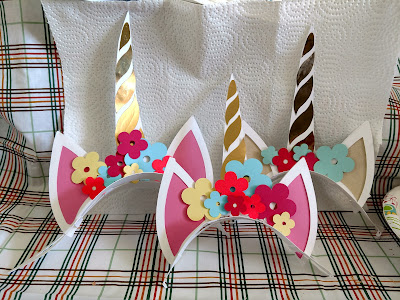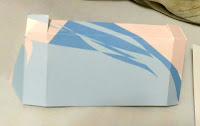We're of that ilk of people for whom teddy bears are "real" (think: "Velveteen Rabbit" real), and so when we read that Smokey Bear was coming to town to celebrate his 75th birthday, and that there was geocaching involved, our
geo-trackable teddy bears got all excited and wanted to do something to celebrate.
They've also been after me for t-shirts for the warm weather. (Donovan usually wears a
hand-knit Christmas sweater after Thanksgiving, and a
hand-knit Irish Fisherman Sweater most of the rest of the winter, while Lambie wears a
hand-knit Maple Leaf sweater, celebrating his Canadian heritage (we found him at a gift shop in Halifax, Nova Scotia. Donovan started life as a Boyd's Bear with a renfaire mission, traveling with us from Renaissance Faire to Renaissance Faire, usually dressed in
1570s-era Spanish Court attire.)
The first Smokey 75th graphic I saw, attached to the Mid-Atlantic Forest Fire Compact's commemorative
Smokey Bear GeoTour passport, was set against a night forest sky. A nice rectangle for something that would look like a "band" t-shirt, and since spokesbears like Smokey are the equivalent of rockstars to the teddy bear world, highly appropriate.
Not wanting to sew an entire pair of t-shirts from scratch, I found Lambie would reasonably fit the top half of a newborn-size onesie. I still would need to sew Donovan's shirt from scratch. Since I was using white fabric, I sized and printed the GeoTour logo on light-fabric iron-on. I also double checked my heat settings: the 400F cotton setting suggested for iron-on was hotter than my original Cricut EasyPress goes, so it was off to the regular iron. (Besides, these shirts were really
too small for a heat press.)
Sadly, even with the higher temperature, the transfer looked incomplete and extremely washed out.
Additionally, Donovan's shirt was a bit tight, the neckline a bit feminine, and the sleeves too long.
 |
| Donovan (left) and Lambie in their original Smokey Bear T-shirts |
So I recut Donovan's shirt, reprinted the graphics on dark-fabric iron-on, and went from there. Meanwhile, my sister's trackable bear Mink (and his sidekick Del Sol) needed to garb out as well. Mink is tiny enough that the best I could do for him was a singlet with a version of the
official Smokey Bear 75th birthday logo. Del Sol, even smaller, could only manage a superhero-style cape. And so the bears were now ready to party with Smokey Bear.
 |
| The bears explore the photo props at Smokey's birthday party |
Once we decided that we
were going to celebrate Smokey's birthday at Liberty State Park, it occurred to me that we should get the
people in the household involved in the t-shirt project, just like those families who do Disney parks in matching t-shirts. For this, we chose the official logo (following the
proper logo guidelines) for the upper left corner of our shirts, with the geocachers' names on the back along with #SBGT for "Smokey Bear GeoTour". As a non cacher, I refer to myself as a "geo tag-along" and put that on the back of my shirt.
The official color Smokey 75 logo is meant to be produced only on a white or khaki background; all other color backgrounds require a single color white or black logo
(logo guidelines here). Since the bears were going to be wearing white, we would wear white also, making it easy to use the color logo.
You may recall from
a previous post that iron-on transfers require the "cotton" temperature setting, which is hotter than my original EasyPress will go; I therefore used a regular iron. I tested one of my spare light-color transfers using the iron's cotton setting, and found that even with the high heat setting and pressure, the transfers looked washed-out on a white T. While the white background of dark-fabric iron-on transfers would not necessarily show up on a white shirt, I find that the more superfluous iron-on kept in the transfer, the less flexible the stretchy t-shirt is, and the more like an "iron-on heat transfer t-shirt" it appears. (This is one issue I had with early Café Press products...)
Of course, I have a Cricut — which means I can use Print then Cut to perfectly (or near perfectly) trim the transfer! On the other hand, the Smokey 75 logo typeface has a distressed look with a lot of open spaces, and the logo itself has some open spaces as well. The third issue is trying to figure out the correct settings for cutting iron-on transfers.
Since there are two methods of uploading a complex graphic to
Design Space, I found the key was to upload the image twice: once as the Print then Cut file I wanted to produce, and once as an outline Cut file. In both cases, I removed the white background. For simplicity's sake, I chose to not worry about cutting out the centers of my letters (which I would have needed to do if I were printing the logo for a khaki shirt).
 |
| Print then Cut, and Cut only, uploads |
To prevent the program from cutting out all those micro-holes, I sized Cricut's basic shapes (mostly rectangles) to match the widths of my distressed letters, and welded them to the Cut-only graphic. After welding out all the tiny distressing holes, I aligned my cut image with my color image, moved my color image to the top, changed my Cut only image to white, and flattened the two layers. This gave me a color image with simplified cutouts (you can see the white that remains where the "5" meets the birthday balloon).
I changed my Design Space background to blue so you can see the effect:
While my images were small enough to fit two to a page, Design Space didn't want to set them up to cut that way. As a result, I needed to duplicate my logo, put the two copies side by side, and Attach them to save iron-on material. Unfortunately, this ended up with some stray cuts through my image. (Fortunately, nothing that couldn't be faked through with the appropriate use of HTV transfer tape... but I'm getting ahead of myself.)
 |
| Notice the centers of the "B", "R", "D", and "A" have not been weeded. A white circle behind Smokey was needed to avoid Design Space adding a cut line across the bottom of Smokey's face. The balloon string separated from the carrier paper and is curled up in the upper right of the image. |
As you can see from my printed, cut, and weeded sample, my image has a number of separate elements which must be aligned correctly to produce the copyrighted image. As an image printed on opaque medium, the adhesive side is attached to the carrier sheet. I needed some sort of transfer tape to keep my elements aligned for heat transfer. Fortunately, I had purchased a yard of the stuff from
Ante Up Graphics, from whom I purchased my "Infinite Galaxy" Siser EasyPatterns
® back in June. It's called "Siser TTD High Tack Mask", and it's used pretty much the same way transfer tape is used for adhesive vinyl projects.
Using the TTD High Tack Mask is not without its own issues. Like the carrier for normal HTV, the material is not as impervious to heat-press temperatures as I'd like it to be: it warped for almost every project I've tried it on, occasionally releasing an improperly-adhered (or non-adhered) design element, and iron-on ink sticks to it and comes off on the next project.
In the end, all of our Smokey Bear 75 garb was a hit, and the three people had as much fun as the four teddy bears did geocaching and chasing down Smokey for pictures.
























































